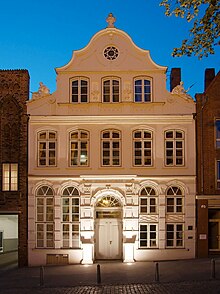Citizen nobility
Citizens' nobility is a socio-structural term used to designate the bourgeois upper class in societies such as republics that are not dominated by aristocrats .
It was characteristic of the bourgeois nobility that they relied on their origins and overcame the common disdain for the citizen by the nobility, which was rooted in the fact that they could not demonstrate any gender sequence. The bourgeois nobility formed closed marriage circles . He lost his prominent position through the reforms in the Rhine Confederation states, in Prussia and later also in the other German states through the civic concept of equality and the gradual implementation of the municipalities.
The citizen nobility is to be distinguished from the older city nobility (see e.g. Nuremberg patriciate ), who asserted their equality and belonging to the nobility at an early stage. Since the late Middle Ages , many European city-states (the trade republics), e.g. B. in the imperial cities , Hanseatic cities , the Republic of Venice , Florence , the Republic of the United Netherlands or in Switzerland ( patriciate of the old Confederation ), bourgeois patricians of commercial character emerged, but they had aristocratized early (city aristocracies at the head of so-called " aristocratic republics " ); These older bourgeois ruling classes were often replaced by new economic elites in their local spheres of activity from the end of the 18th century in the course of revolutions and industrialization.
Citizen nobility, on the other hand, is a term for the bourgeois upper class that has been forming since the 17th century. Likewise, the bourgeois nobility must be distinguished from the “ money nobility ”, which included large industrialists who could afford a quasi-aristocratic lifestyle. Some of them were ennobled for their services, as were often less well-off bourgeois professors, officers or civil servants, others acquired their titles of nobility in certain monarchies (notorious for this were the Duchy of Saxony-Coburg , the Kingdom of Portugal , the Republic of San Marino and the Papal States ). All of these new nobles were counted as part of the so-called " Second Society ".
The Hanseatic League was an example of the bourgeois nobility . Hereditary citizenship, bourgeois colleges and the right to self-amendment of the Senate formed the basis in Hamburg for “the fundamentally oligarchic character of the Hamburg constitution ..., the constitutional order was therefore interpreted as an aristocratic and not a democratic one”, one of the reasons why Hamburg “as City republic in 1815 was able to become a member of a league of sovereign princes . ”At the same time, there was hardly anything more unhanseatic than the acceptance of nobility, even the designation as“ citizen nobility ”does not correspond to the Hanseatic self-image (cf.“ Hanseatic nobles ”). The Hanseatic culture that had grown in the oldest citizen republics of Hamburg , Bremen and Lübeck was essentially bourgeois in its own right and not a simple feudalization of the bourgeoisie in the sense of adapting to the nobility . An essential difference was in the bourgeois-professional ideal of performance, mostly of a commercial character, as well as in the more subtle display of wealth, while for the nobility, representation through pomp and splendor always remained style-forming. The distance between the bourgeois nobility and the nobility was so pronounced that of the well-known trading cities, Bremen was the one with the lowest rate of marriages between upper class and aristocrats. The family tradition that shaped the bourgeois nobility was particularly pronounced in Hamburg and Lübeck. It replaced the missing feudal structures and was a foundation of the urban common good. The reverence for the rise of one's own family dominated the domestic and urban life of the “upper ten thousand”, often not without, as Ida Boy-Ed described it, “the specific Hanseatic disease: the patrician madness in which every family imagines it is more aristocratic than all To be different. ” Thomas Mann describes the decline of a Lübeck Hanseatic family in his novel“ Buddenbrooks ”, in which he processed the story of his own Mann family .
See also
Individual evidence
- ↑ Cf. for Cologne: Eduard Duller, Karl Hagen: German history from the oldest times to the 19th century , 1862, p. 76.
- ↑ Lutz Hagestedt: Similarity and Difference: Aspects of the Conception of Reality in Ludwig Tieck's late novels and short stories , 1997, p. 93.
- ↑ Hildegard von Marchthaler: The importance of the Hamburg gender book for Hamburg's population and history , Hamburg gender book volume 9 = German gender book volume 127, p. XXII.
- ↑ Chong One Rhie: The emergence of the second society: The nobility policy in the Habsburg Monarchy in the 19th century, especially to Jews in Austria , text version online ( page no longer available , search in web archives ) Info: The link was automatically marked as defective. Please check the link according to the instructions and then remove this notice.
- ^ John F. Jungclaussen: Cracks in white facades - The decline of the Hanseatic civil nobility , Munich 2006, ISBN 978-3-88680-822-9 .
- ↑ Peter Borowsky: Does the “citizenship” represent the citizenship? Constitutional, civil and electoral law in Hamburg from 1814 to 1914 , in: Schlaglichter historical research. Studies on German history in the 19th and 20th centuries , Hamburg undated, p. 93.
- ↑ Jens Jessen : What remained of the nobility. A Bourgeois Contemplation , pp. 26-27, on Klampen Essay 2018, ISBN 978-3-86674-580-3 .
- ^ Matthias Wegner: Hanseaten , Berlin 1999, pp. 96 and 111.
- ↑ Ida Boy-Ed: A royal merchant , Stuttgart and Berlin 1922, p. 29, text version on Commons: Image: Boy-Ed A royal merchant.djvu.
